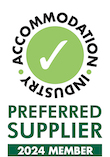Place Settings for Silverware: The Complete Guide
A lot goes into hosting guests. It is an art.
Every detail counts: from picking the theme of the occasion to the choice of food, the table set up and even the silverware to use.
But silverware is often overlooked. It is usually the last item to consider when thinking of how to set a table at your restaurant.
Do not make that mistake.
Pay attention to how you place silverware on the table. It can leave an impeccable impression among guests.
Proper table etiquette dictates that you use specific silverware in particular settings. For example, you should only use a salad fork to eat a salad.
With that in mind, let’s first understand the different types of silverware.
1. Spoons
There are different types of spoons. They vary in size and use.
-
Coffee spoon. People often use a teaspoon to stir both tea and coffee; the coffee spoon is less common.
It is smaller in size than a teaspoon and is ideal for stirring coffee when served in a small coffee cup.
- Teaspoon. It is used for stirring beverages such as tea. Usually, it is in a measure of 5 ml.
- Soupspoon. It is round and large to allow you to eat soup easily. If the soup contains vegetables, breadcrumbs or meat, use an oval soup spoon.
- Sundae / Ice-cream spoon. This kind of spoon is long and ideal when indulging in ice-cream served in a sundae glass.
- Dessert spoon. Use it when eating soft desserts such as custard, pudding or ice cream served in a bowl.
- Dinner spoon. It has a shallow, oval-shaped bowl and is commonly referred to as a tablespoon.
2. Forks
- Dinner fork. It stands out, as it is the biggest fork on the table setting. With its long, tapered tines, one can pierce food such as steak. Use it in the main course for both formal and informal dining.
- Fish Fork. It differs from other forks because of its curved shape. Its left tine is usually larger than the others and has a notch used for removing bones.
-
Salad fork. When it comes to eating vegetables and salads, this is the fork to use. It has broader and flatter tines compared to the rest of the forks on the table.
The tine on the left is usually thicker to make cutting the vegetables easier. Salad forks are used for both formal and informal dining.
- Dessert fork. It looks like a salad fork but is a bit narrower.
NB: The salad and dessert forks are similar in size but smaller than the dinner fork. The salad fork has four tines and the dessert fork has three.
-
Oyster fork. It is also known as a seafood fork. This is good for a variety of seafood, such as shrimp or shellfish.
When setting the table, this is the only fork you place on the right side of the dinner plate. The rest of the forks go to the left side of the dinner plate.
3. Knives
Knives are designed for specific tasks, such as chopping, spreading or slicing, among others.
You will know the task of a knife by looking at its blade. The blade could be pointed and thus used for paring fruits or serrated and used for cutting meat.
Butter knife. It is the smallest knife in a table setting. Use it for spreads such as cheese or butter on bread.
Dinner knife: It is the longest knife at a table setting. You will find it in both formal and informal settings.
Steak knife: It comes as serrated or non-serrated depending on specific steak cuts.
During formal dining, if you serve meat that is roasted, boiled or fried, don’t place a steak knife on the table. Instead, guests can use a dinner knife because the meat is tender.
Dessert knife: If you are serving a cake or pastry as dessert, then you must provide guests with a dessert knife. This will be used together with a dessert spoon.
Fish knife. It has a wide blade and a tip made with a notched point. This is to help separate the bones of the fish.
Now that you’re a pro at distinguishing the different types of silverware, it’s time to understand how to place them when setting a table.
A well-set table makes your guests feel special. They are more likely to enjoy their meal in a beautiful setting.
Lay your silverware on quality food and beverage linen.
You can get these from a trusted supplier like Australian Linen Services. They have an extensive range of linen. This gives you a variety of choice.
Steps to Place Silverware
There are generally three categories of settings. These determine the silverware you will use.
- Basic setting
- Formal setting
- Informal setting
Basic Setting
When setting up a table use the acronym FOrKS to recall the placing order from left to right.
F is for Fork
O is for the Plate
K for Knives
S for Spoons
- Begin by placing the dinner plate at the centre of the place setting.
- Place the fork on the left of the dinner plate.
- The knife goes to the right of the dinner plate. Make sure the sharp edges of the knife face the plate.
- On the right of the knife, place the spoon.
- The napkin either goes to the left of the fork or on the dinner plate.
Formal Setting
This is usually a dressed-up occasion. Guests will wear formal attire to match the setting.
 Image from: BUTLERS GUILD
Image from: BUTLERS GUILD
Your silverware should be in the order below:
- At the centre of the place setting, lay the charger or service plate. The charger is not used for eating. Make it part of you.
- The dinner plate is where you serve the main course. Place it at the top of the charger.
- The soup bowl goes to the top of the dinner because you will serve soup as a starter.
- The dinner fork goes to the left of the plate, next to the salad fork. Always place your forks with the prongs facing upwards. Placing forks with prongs facing down indicates you have finished dining.
- On the right side of the dinner plate, place the dinner knife. When dining, don’t cut your food and then place the knife down to eat with a fork. Instead, use both the knife and fork.
- Use cutlery from outside to inwards. This means that the soup spoon should be next to the salad knife and the dessert spoon to the top of the plate. The dessert fork goes to the left of the plate.
- Side plates go to the left of the charger with a butter knife on top. As for wine and water glasses, place them at the top right-hand side of the charger.
-
Impress your guests by folding your napkins in different styles and place them next to the forks.
Check out this video to learn creative ways of folding your table napkins:
Informal setting
This being a casual setting, it gives you room for creativity when setting tables.
Cutlery is always placed in order of use. The farther inside it is, the further it will be used into the meal.
- In this setting, you can do away with some of the cutlery on the table. For instance, omit the charger and place only the dinner plate on the place setting.
- Forks always go to the left. Place the salad fork followed by the dinner fork.
- The knife is placed on the right of the dinner plate followed by the soup spoon. When serving water and wine, always use different glasses. Place your glasses above the knives.
With these in mind, you are now set to impress your guests.
Remember to pick high-quality food and beverage linen that will match up to your place setting.
Australian Linen Supply is a trusted brand that has stood the test of time.
Check out Australian Linen Supply today!.
Feature Image: WikiMedia















